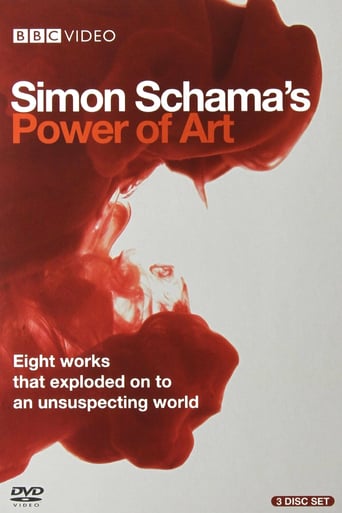GertrudeStern
Simon Schama's introduction to Caravaggio -- who he was, what he was doing, how other people felt about that -- is sometimes rudimentary, but truly hypnotic. The hypnosis is only broken when Schama looks closely at a painting (his looking NOT being rudimentary) and says something super gut-busting with his weird cadences and intimacy.For instance, in the Caravaggio ep, Schama dives into The Musicians, a piece featuring a cupid, a boy sadly tuning a stringed thing and baby Caravaggio himself, at the back of what Schama calls "this tight little group". Schama's ensuing analysis of the painting includes the lines "The lead singer is crying his eyes out, and he's just tuning up," and "(intruder) Oh yes, four youths in a closet. Exuse me, so sorry, don't mean to intrude! (tight little group) No no, come on in, darling, pull up a cushion, join us, we're just rehearsing." All of this is said in the most coy VO anyone has ever produced. He calls the painting "fleshy" and "claustrophobic". Really he just crushes it.This series is worth watching for the re-enactments (many, many good re-enactments), but worth suggesting for Schama's magnetism and keen observations. We should probably make sure this is finding the farthest reaches of space. 9/10!Update: I know some viewers are hot and cold on his unfolding of Bernini, but Schama's comments on the folds of The Ecstasy of Saint Teresa ARE enjoyable and that ep. IS dope.Update 2: He calls Rembrandt "Mr. Clever Clogs"!Update 3: Make it to the end of this series and you get to actually watch someone reenact Simon Schama himself as a 20 y/o ruffian staring at a Rothko. This man is a genius.
blob blobblob
If Mr. Schama spoke any more slowly, more painstakingly divided his syllables, I might not recognize the language he speaks in.More importantly, the writers and directors of pieces like this should recall what information is available at almost every viewer's fingertips. One can access a summary of most documentary subjects literally within a few minutes. I tested this hypothesis with the hour long piece on Turner. In a few keystrokes, I was able to find two summaries on the web that included most of the data Schama presents. Perhaps ten, 15 percent of what Schama tells or shows us remained harder to find, and what consisted of original analysis was nearly absent.And what is the purpose of the cinema-like shots that suggest some sort of hint toward reenactments? There is often little rhyme or reason to when or why they occur. They last a second or two and seem selected based on their potential for filler and gloss. At one point, we see a hand in shallow focus scraping at a canvas. This is supposed to help us imagine Turner doing his work as a painter? Gimme a break.Watching something like this is nearly a waste of time. I suppose you could turn down the volume and imagine your own narration. Better still, go to a museum or library instead. At least you'll get off your couch.
amandabernice
Simon Schama's delectably paradoxical look at some of the great names in art uses a humanistic approach in viewing The Great Masters that at once humbles their genius as flawed humans and exalts their glorious talent. At once witty, sardonic, and sexy, Schama's approach to art couples socio-historical scholarship with the pure joy in viewing something that invigorates the eye, the brain and the heart.The Power of Art utilizes Schama's wonderfully written narration he brings to so many of his BBC documentaries, as well as beautifully staged and acted mini-dramas to capture the artist's historical context.By appealing to the everyman's enjoyment of beautiful art, the scholar's love of history, and the artist's appreciation for the myriad influences and subtleties of the craft, Schama's Power of Art is simply lovely.
Tenate9
I have only watched Simon Schama's diatribe on Bernini and this 'review' is only on that one episode but I tend to think it's indicative of the whole series or even of his TV work in general. The write up in my local online listing said : Bernini's Ecstasy of Saint Theresa shows a nun in the state of orgasmic bliss. How was it ever allowed? Simon Schama tells a story of sex and the sacred in Seventeenth Century Rome. The ultimate premise of the show is that after a rise and fall style career Bernini ( whilst not so favoured - 'POPEular' - as when at his summit ) Made the 'Ecstasy of Saint Theresa' sculptural masterpiece - which again thrust him into the limelight. Schama's thesis is that this 17 Century Baroque tour de force or gaudy, kitsch ode to the farrago that is superstition - viewed from a non-observable angle ( false from the perspective of an observer ) can be seen that the angelic spear holder is about to 'shove' the spears 'head' up her in a very sexually provocative manner - her face in a climactic climax at this 'Charismatic' event. This is bizarre and if you see this work as it's meant to be seen, the angle of the 'thrust' is into her heart ( As the original mythic story suggests - the divine joy/sleep of God etc... ). That the face, in a state of orgasmic delight or the last moments of death, tortuous pain or just dozing off are all same is very well known and doesn't add anything to his platitudes on Art, sex or Bernini. It seems to be just a fantasy of, or a cheap trick to put some sex appeal into this, not even slightly charismatic TV historian.

